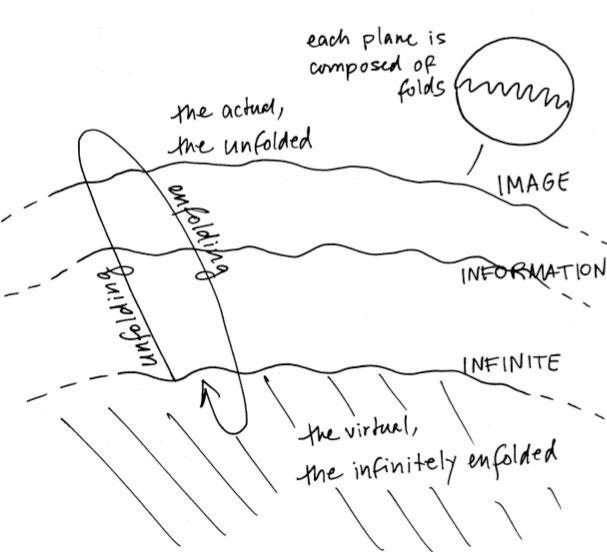Curator's Note

Aesthetics privileges the analysis of perceptibles, what appears to the senses.[1] But the senses are portals to what cannot be sensed yet. When we think about where the things we perceive come from, I want us to be thinking about the virtual, the infinite, and also something so physically real that it is utterly unknowable to us. Enfolding-unfolding aesthetics helps us to be alert to the seemingly nonexistent as it rolls into being.
Enfolding-unfolding aesthetics answers the question: Where do images, those things that we perceive with our senses, come from? From the infinite, unknowable in itself. The infinite appears as chaos, though we may sometimes intuitively taste it. The processes of unfolding from the infinite and enfolding back into it are constant, additive flows. The infinite is expanding—though also our cosmos, in this time of environmental devastation, is getting smaller.
With enfolding-unfolding aesthetics, a receiver can get a sense of where things come from, the image’s material, historical, and cosmic sources. Images, which I define as all perceptibles, cycle through time and space to reach our body and our senses. As they cycle, they collect noise and interference, augmentation, and diminution. In the method of enfolding-unfolding aesthetics, by comparing what you perceive with the interface that shaped it, you can get a sense of where it has come from and what it has passed through. A little part of the universe finally reaches your body! The sensation when the image connects to its source through your body is the feeling or affect of unfolding: it can feel like shock, joy, sorrow, or many other things. It is precious data.
Here’s a very schematic diagram of the cycle of enfolding-unfolding aesthetics. The process describes the prehensions of every ensouled being, not only humans, though here I am focused on human processes of enfolding and unfolding.
This diagram, which I have been developing over the years (it first appeared in Enfoldment and Infinity: An Islamic Genealogy of New Media Art, MIT Press, 2010), models the cosmic flow of enfolding and unfolding in two views. One, which places the perceiving/prehending being at the center, shows how the cosmos unfolds to their point of view. The other shows the cosmos itself, with the perceiver/prehender on the outer edge. In both, time is represented in the spiral motions of unfolding and enfolding. In its roughly circular form and quaint, naive attempt to press a flowing, multidimensional spacetime into a flat image, my diagram recalls medieval cosmological diagrams.
With its attention to how things unfold from chaos or the infinite, enfolding-unfolding aesthetics can be used to analyze not only images but any phenomenon, including concepts. The method extends to historical and cultural research, and it can be used to unfold many kinds of nodes in many disciplines. Because the arts reflect, model, and reimagine the cosmos, they are especially fruitful media for doing enfolding-unfolding aesthetics.
Add new comment